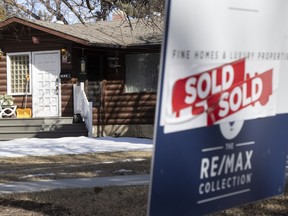
The tentative recovery in the Toronto-area real estate market has given way to another bout of the jitters.
Listings are surging in February and buyers are pulling back, industry players say.
The anxiety surrounding U.S. President Donald Trump and his threat of imposing hefty tariffs on imports from Canada has smothered the positive signs that were beginning to emerge, says John Pasalis, president of Realosophy Realty.
“The sellers are there, but the buyers are on the sidelines. It’s leading to a very sluggish market, and now we have this massive cloud of uncertainty.”
In January, sales in the Greater Toronto Area fell 8.9 per cent compared with the same month last year, according to the Toronto Regional Real Estate Board.
Active listings, meanwhile, ballooned 70 per cent last month from January, 2024.
Sales in January increased 10 per cent compared with December on a seasonally adjusted basis, according to economist Daren King of National Bank of Canada. That improvement followed an 18.2 per cent dive in December from November on a seasonally adjusted basis.
“On the supply side, it has become apparent that the cumulative fall in interest rates has prompted many sellers to list their homes in the face of what could be a good year for the housing market,” Mr. King says in a note to clients.
New listings soared 26 per cent from December to January and reached their highest level since March, 2021, he points out.
Active listings swelled by 10.5 per cent during the month to their highest level since January, 2009.
With looser market conditions, prices remained flat from month-to-month, Mr. King says.
At times it’s difficult to suss whether sellers are sanguine about the outlook or fearful of what’s to come.
Mr. Pasalis points out that buyers began jumping back into the market in greater numbers in October and November as they aimed to take advantage of a decline in interest rates while prices remained soft.
Many of those fall buyers were betting that further interest rate cuts would lead to a busy market and possible run-up in prices in the spring.
Mr. Pasalis says he and others in the industry were more subdued. He was predicting a slight uptick in the spring but not a strong rebound and certainly not a return to the frenzy of 2020 through 2022.
The upcoming provincial election in Ontario and possible federal election in the spring don’t appear to have unsettled people to any great extent, he says.
“The tensions in the U.S. are causing all the concern,” he says.
Mr. Pasalis cautions that some aspiring sellers are still more optimistic than they should be, given the current mood.
He reminds sellers that they need to be realistic and patient.
“Even if you’re priced well, it will take longer,” he says.
Mr. Pasalis says about 25 per cent of homes in the low-rise segment in the GTA sold above asking in January, but those that do receive more than one offer tend to be starter homes in the most desirable neighbourhoods.
He adds that the listing agents often set an eye-catching asking price, but buyers are not bidding aggressively.
“Yes they’re selling over asking, but the agent priced it low and they end up selling for close to what they’re worth.”
During the heated market of two years ago, he says, 80 per cent of homes in the same segment were selling above asking. In March of 2024, more than 50 per cent of low-rise properties were selling above asking.
He doesn’t see a return to the days of homes drawing 20 offers and selling for “insane” prices any time soon.
Mr. Pasalis had a few risks for the GTA housing market on his radar screen for the coming year – including the fact that buyers of newly-completed condo units are increasingly having trouble obtaining financing as appraisals come in below the original purchase price – but those concerns have been overshadowed by Mr. Trump’s return to office.
“This has now become the bigger economic issue,” he says, because workers in some industries will be worried about their jobs.
He won’t be surprised if banks become more conservative in their lending as well.
Pritesh Parekh, real estate agent with Century 21 Legacy Ltd., says the optimism he was sensing from buyers at the beginning of January has given way to uneasiness.
While buyers were feeling more positive with spring on the way and interest rates on a downward trend, the tariff fight has infused the market with anxiety.
The chatter he is hearing more recently revolves around the imposition of tariffs and what impact they will have.
“What does this mean to me? Does it mean anything at all?” is a common sentiment. “When people have questions they sometimes slow down in their journey.”
Even beyond talk of levies and the potential disruption to the economy, Mr. Parekh notes that aspiring buyers were already reining in any exuberance.
In December, new rules came into effect which allow buyers in the $1-million to $1.5-million range to qualify for an insured mortgage. The policy change allows buyers to purchase a home in that segment with a down payment of less than 20 per cent.
Mr. Parekh has been sharing news of the rule change with every buyer he has talked to since mid-December, but no one has shown interest so far
In reality, the policy only helps a very small pool of buyers who don’t have a substantial down payment saved up yet still have an income high enough to afford the monthly payment, Mr. Parekh points out.
“They’re still mentally sticking to a $1-million price point,” he says.
Mr. Parekh believes the discipline buyers are showing partly stems from the rapid rise in interest rates after the Bank of Canada began a tightening campaign in March of 2022.
“That instilled some alarm in people, and they remember that anything can happen.”
Farah Omran, senior economist at Bank of Nova Scotia, notes the one thing that has been most constant recently is the uncertainty facing economic forecasts.
In 2024, Ms. Omran says in a note to clients, sales across the country saw upward and downward moves cancelling each other out over the months. For the most part, the national housing market stayed in balanced territory with stable prices, she adds.
Ms. Omran says unpredictability will continue in 2025, with a lot hanging on the scope, timing and permanency of tariffs, as well as Canada’s chosen strategy for retaliation.




